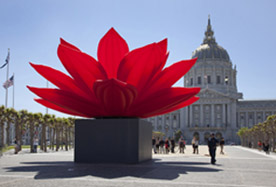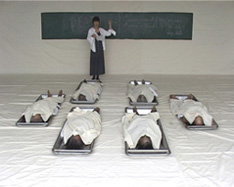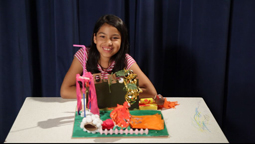 |
|
 |
| Korean artist Choi Jeong Hwa's massive kinetic lotus, Breathing Flower (2012), installed outside the Asian Art Museum in Civic Center Plaza, San Francisco. Fabric, LEDs, motor. © Choi Jeong Hwa, courtesy of the artist. |
|
Araya Radsjarmrearnsook, The Class (2005), a video work in which the artist lectures an audience of cadavers about death. © Araya Radsjarmrearnsook, courtesy of 100 Tonson Gallery. |
On a recent trip to the U.S. I stopped off in San Francisco and took a look at the Asian Art Museum's current show, Phantoms of Asia. Bringing together some 150 works by contemporary artists from all over the continent, it's an ambitious undertaking with a theme to match: "exploring spirituality and the afterlife." As with the Olympics, the visitor tends to compare one country's collective output with another's, despite the curators' best efforts to mix the artists up in a series of topic-specific galleries. Japan is well represented, of course, but mostly by big names like Hiroshi Sugimoto or current media darlings like Fuyuko Matsui and Motohiko Odani. For Japan residents already familiar with them and with artists from nearby Korea and China, the real thrill here is to be exposed to some very exciting contemporary art from India and Thailand. One standout is Araya Radsjarmrearnsook's astonishing video piece, at once satirical and moving, in which the Thai artist literally confronts death in the form of a classroom of shrouded corpses.
Serendipitously, the show also introduced me to a Japanese artist I had not encountered here in the homeland: Takayuki Yamamoto, a creator of highly imaginative, funny, and thought-provoking work on video. Though he has attained some visibility on the domestic scene over the past decade, Yamamoto appears to be better known overseas, particularly in Europe, where he has exhibited widely (he studied art in the U.K. for two years).
 |
|
 |
| Takayuki Yamamoto, What Kind of Hell Will We Go (2012), dioramas and video on display at the Asian Art Museum, San Francisco. © Takayuki Yamamoto, courtesy of the artist. |
|
Children from Bayview, San Francisco, describe their Hell dioramas in the video What Kind of Hell Will We Go, currently at the Asian Art Museum. © Takayuki Yamamoto, courtesy of the artist. |
Yamamoto's San Francisco installation consisted of a video monitor surrounded by a dozen small cardboard dioramas of . . . Hell. These were constructed not by him, but by elementary schoolchildren in San Francisco's low-income Bayview district. A former teacher, Yamamoto has a knack for getting kids to make the darnedest things, it turns out. For his "New Hell" project, he introduces them to medieval Japanese paintings of the Buddhist Hells -- which, he emphasizes, are not a permanent destination, but merely a way station en route to Paradise. He then provides the kids with the materials to construct a model of their very own underworld -- with their own vision of punishments for whatever wrongdoers they wish to torment. So far, children in places as far-flung as Bayview, Croatia, and Yamamoto's native Nagoya have responded to his invitation with gusto. Some of their videotaped interviews, in which each young artist is given ample time to describe his or her personal Hell in lavish detail, can be seen
here. (English subtitles are provided.)
Conjuring up a Hell of one's own making proves to be an endeavor that offers revealing, and sometimes disturbing, glimpses into the inner lives of children, as well as the problems they must deal with in their environment. Bayview is considered one of San Francisco's more dangerous neighborhoods, so it comes as no surprise that many of the young Bayview artists reserve their harshest penalties for "people who kill or rob other people." Others, however, are content to vent their wrath on such targets as "people who use mean words." Tellingly, the punishments are almost always more severe than the crime. Knives, snakes, and man-eating sharks make frequent appearances, suggesting that movies, TV and video games may be as much an inspiration as the reality outside the door.
 |
|
 |
| Children from Bayview, San Francisco, describe their Hell dioramas in the video What Kind of Hell Will We Go, currently at the Asian Art Museum. © Takayuki Yamamoto, courtesy of the artist. |
Even in the comparatively nonviolent social environment of Japan, the youngsters' imaginations appear to be equally bloodthirsty, though the evildoers they identify for retribution are more likely to be bullies at school than scary adults. A friend of mine expressed horror at the thought of intentionally encouraging children to think about Hell, but my impression is that the kids in these videos enjoyed the process immensely. They describe their instruments of torture with a winning blend of show-and-tell enthusiasm and innocent offhandedness. Mostly, they appear thrilled to be on camera. And of course, their Hells are never for them or their friends, but for other people -- those who do bad things and deserve to get what's coming to them.
In case the reader is tempted to think that Yamamoto has a macabre or sadistic streak in him, I should point out that he has done many other video projects with children on far lighter themes, with charming and often hilarious results. As part of a group exhibition currently at the Takamatsu City Museum of Art in Shikoku, Yamamoto is showing his video
Telling Your Future, in which some very young would-be clairvoyants sit in their homemade fortune-telling booths (the real thing is an ubiquitous sight on Japanese city streets) and solemnly inform strangers what's in store for them.
In a videotaped English-language
interview, Yamamoto explains his m.o. with kids: starting off in authoritative teacher mode until he has cajoled them into becoming equal participants in the project at hand, he then gradually withdraws to the background, encouraging them to "do their own thing" without concern for pleasing their teacher. Confronted with this sudden independence, he says, a child may experience feelings of uncertainty and "vagueness" -- but also a surge of creativity. And that's what art and life are all about, right? "You can feel this imagination going on," Yamamoto says. "Even if it's a crappy thing, it's good!"
 |
|
 |
| The youthful "Ms. Bunny" (left) and "Socks" (right) fortune-tellers ply their trade in the video Telling Your Future, currently at the Takamatsu City Museum of Art. © Takayuki Yamamoto, courtesy of the artist. |